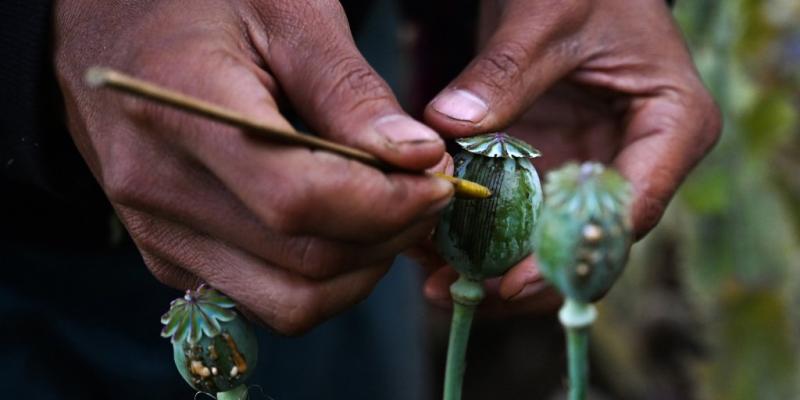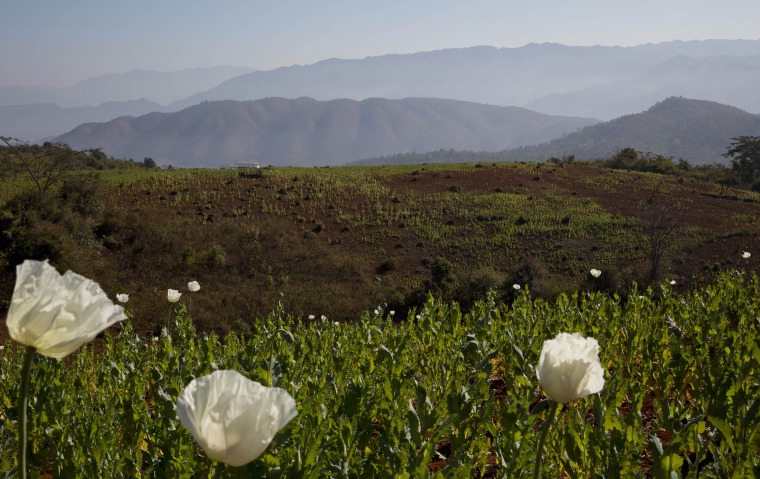War-wracked Myanmar is now the world's top opium producer



BANGKOK — Myanmar, already wracked by a brutal civil war, has regained the unenviable title of the world's biggest opium producer, according to a U.N. agency report released Tuesday.
The Southeast Asian country's opium output has topped that of Afghanistan, where the ruling Taliban imposed a ban on its production, the United Nations Office on Drugs and Crime said in its "Southeast Asia Opium Survey 2023."
The Taliban's ban has led to a 95% drop in the cultivation of opium poppies, UNODC said last month. Opium, the base from which morphine and heroin are produced, is harvested from poppy flowers.
From 2022 to 2023, Myanmar saw the estimated amount of land used to grow the illicit crop increase 18% to 47,100 hectares (116,400 acres), the new UNODC report said.
"Although the area under cultivation has not returned to historic peaks of nearly 58,000 ha (143,300 acres) cultivated in 2013, after three consecutive years of increases, poppy cultivation in Myanmar is expanding and becoming more productive," it said.
It also noted that the estimated opium yield expanded by 16% to 22.9 kilograms per hectare (20.43 pounds per acre) — topping the previous record set in 2022. It attributes that increase to "increasingly sophisticated means of cultivation, including increased plot density, improved organization of plants, and enhanced practices, such as the use of irrigation systems and potentially fertilizers."
The violent political turmoil in Myanmar has contributed to the opium production increase.
"The economic, security and governance disruptions that followed the military takeover of February 2021 continue to drive farmers in remote areas towards opium to make a living," UNODC Regional Representative Jeremy Douglas said.
The report notes that "opium poppy cultivation in Southeast Asia is closely linked to poverty, lack of government services, challenging macroeconomic environments, instability, and insecurity."
For farmers, the bottom line is simple economics.
UNODC said the average price paid to opium growers increased by 27% to about $355 per kilogram ($161 per pound), demonstrating the attractiveness of opium as a crop and commodity and strong demand.
The figures mean farmers earned around 75% more than in the previous year, said the U.N. agency.
 Flourishing poppy fields spread through hills at Nampatka village, Northern Shan State, Myanmar.Gemunu Amarasinghe / AP file
Flourishing poppy fields spread through hills at Nampatka village, Northern Shan State, Myanmar.Gemunu Amarasinghe / AP file
Douglas said that armed conflict in Shan state in Myanmar's northeast, a traditional growing region, and in other border areas "is expected to accelerate this trend." An offensive launched in late October by an alliance of three ethnic armed groups against Myanmar's military government has further destabilized the remote region.
Northeastern Myanmar is part of the infamous "Golden Triangle," where the borders of Myanmar, Laos and Thailand meet. The production of opium and heroin historically flourished there, largely because of the lawlessness in border areas where Myanmar's central government has been able to exercise only minimum control over various ethnic minority militias, some of them partners in the drug trade.
In recent decades, as the region's opium production dropped, methamphetamine in the form of tablets and crystal meth has supplanted it. It's easier to make on an industrial scale than the labor-intensive cultivation of opium, and gets distributed by land, sea and air around Asia and the Pacific.
UNODC said in a statement accompanying its report that the region's burgeoning drug production "feeds into a growing illicit economy ... which brings together continued high levels of synthetic drug production and a convergence of drug trafficking, money laundering and online criminal activities including casinos and scam operations."
Cyberscam operations, particularly in Myanmar's border areas, have come under the spotlight for employing tens of thousands of people, many lured by false offers of legitimate employment and then forced to work in conditions of near slavery.
The recent fighting in Shan state is linked to efforts to eradicate the criminal networks running the scam operations and other illegal enterprises.
The Associated Press








Three indigenous groups have combined and a fourth is close to joining the group and have taken over numerous border crossing and land from the military. Hopefully they will take their country back.
I read about the arms sales and manufacturing base in Myanmar several months ago because of an article about international arms sales and manufacturing. If the current government is control of arms manufacturing, I wonder who is going to supply the indigenous groups?
This might have been the article I read.
and more from another article on the extent of imports.
I wonder if the opium production is needed to buy weapons or does Myanmar have other resources to sell?
UN expert: Myanmar military imported $1 billion in weapons since 2021 coup | AP News
Published 6:28 PM CST, May 17, 2023
UNITED NATIONS (AP) — Myanmar’s military has imported at least $1 billion worth of weapons and related material from Russia, China and other countries since its February 2021 coup, some of which it has used to carry out atrocities against civilians, according to a U.N. report released Wednesday.
Andrews said at least 22,000 political prisoners have been detained since the coup, at least 3.500 civilians have been killed and 1.5 million people have been forcibly displaced.
The report documents over 12,500 purchases that were shipped directly to the Myanmar military or known Myanmar arms dealers working for the military from Feb. 1, 2021, when the military ousted the elected government of Aung San Suu Kyi, until December 2022, Andrews said at a news conference.
He said the volume and diversity of equipment the military received was “staggering,” ranging from fighter jets and attack helicopters and drones to advanced missile systems, tank upgrades, sophisticated communications equipment, radar complexes and components for naval ships.
Here is a link to an excellent article on indigenous weapons, they make many of their own.
There are eight races in Myanmar (Burma) the Karen being the one that I'm the most familiar with and they have been fighting the various military groups since around 1960 or so. A very interesting people who I have spent some time with and my wife has some original Karen women's clothes, quite beautiful
Opium is the big money maker for them.
So are rubies and other gemstones.
And natural gas.
Yes, they are. The Kok River runs from Myanmar into Thailand at border town of Tha Ton and continues across Thailand right through the middle of the ''Golden Triangle'' smuggling of gem stones on the Myanmar/Thai border has been going on for decades.
more info on Myanmar's oil industry that the US has not sanctioned. The oil industry is Myanmar's largest revenue source - not surprising.
Rice is another large export crop.
The more I read about Myanmar, I can see why international organizations would desire to control the government to have control of the country's assets.
And Myanmar may be the #1 supplier of methamphetamine according to Wiki.
Years ago, I read that the Taliban banned opium production because it was destroying the people of Afghanistan through becoming addicted. I hope that this does not happen to the people of Myanmar.
I googled for info on Myanmar's population. I used Wiki because it was easy to get a lot of info in one place.
With so much diversity, how has Myanmar ever had a cohesive government that represented by the various ethnic groups?